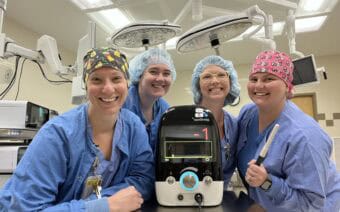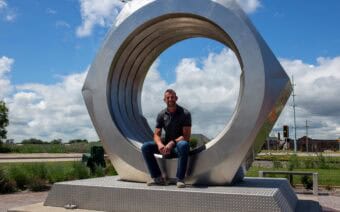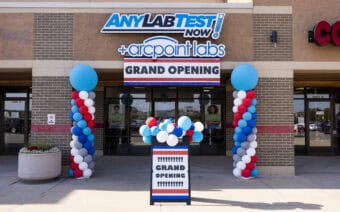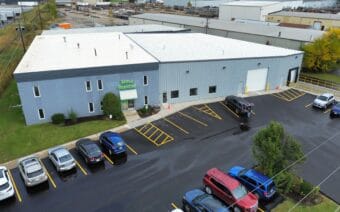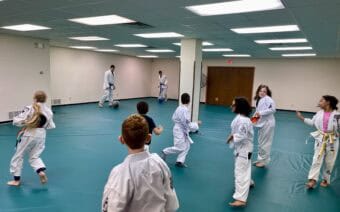
June 3, 2024
GREEN BAY – Bellin Health has long strived to be a leader in health care, including cardiac care.
The team has chalked up another first.
Earlier this year, Bellin Health became the first health system in Northeast Wisconsin and only the fourth in the state to perform a minimally invasive coronary artery bypass grafting (MIDCAB) robotic heart surgery.
In fact, James P. Bailey, a cardiothoracic surgeon at Bellin Health, said it still is not offered in many places throughout the United States.
“The first robotic cardiac surgeries were done around 2003, but they were incredibly rare,” he said. “Even up until probably about the past five years, there were only a few centers in the entire country doing this kind of (minimally-invasive) surgery.”
And, Bailey said, they would happen at places like Mayo Clinic, Cleveland Clinic and University of Cincinnati Medical Center, places like that.
Bailey – who joined the Bellin team last year – said it was at the University of Cincinnati Medical Center that he received his robotic heart surgery training
“I participated in hundreds of robotic heart surgeries during my time in Cincinnati,” he said.
Bailey said he feels fortunate to have completed his robotic heart surgical training under one of the pioneers in cardiac surgery.
“I had the great fortune of training under a surgeon named J. Michael Smith,” he said. “He was, for sure, one of the first 10 in the world to be doing this kind of surgery.”
Bailey said Smith developed many of the cardiac surgical procedures being done robotically today.
“During my training, I worked extensively with him and learned how to do these procedures well,” he said. “I was able to come out early in my career to start one of these programs, which is something that takes a huge amount of effort. We spent months in the process of getting ready to start doing robotic heart surgery at Bellin.”
Bailey said he and his cardiac team performed their first MIDCAB surgery in Northeast Wisconsin in April and have since done several more – all with great success.
He said one patient who had the surgery in early May has already been splitting wood in his yard.
“One of my goals here is to bring Bellin and the Green Bay area into the 21st century when it comes to robotic heart surgery, to bring us to being a cutting-edge program – which I think Bellin has historically been,” he said.
Offers many advantages
Bailey said coronary artery bypass grafting is a standard surgical procedure for treating blocked or narrowed arteries in the heart.
He said it involves taking a healthy blood vessel from elsewhere in the body and attaching it to the artery past the point of blockage to create a detour for blood flow.
Historically, Bailey said this has been done through open-heart surgery where the surgeon makes a large incision and cuts through the breastbone to access the patient’s heart.
During this surgery, he said, the patient’s heart is temporarily stopped, and they are placed on a heart-lung bypass machine.
Though the surgery successfully improves blood flow to the heart, Bailey said it comes with a difficult recovery for the patient.

“It’s a fairly involved procedure to recover from for patients because they’d be recovering with a broken bone, and there’s (greater) risks for infection and risks for problems related to that bone,” he said. “Additionally, the vast majority of surgeons are only doing heart surgery using the heart and lung (bypass) machine, which involves stopping the heart during the procedure.”
Because of the long recovery time and the various risks involved, Bailey said this type of surgery is often not an option for heart disease patients who are elderly, weak or have other health problems, including being on oxygen at home.
“A lot of heart surgeons won’t operate on somebody who is on oxygen at home,” he said. “But one of our first (MIDCAB) patients was on oxygen before surgery. He went home a couple of days after surgery.”
With the alternative MIDCAB surgeries, Bailey said the surgeon doesn’t need to cut into the breastbone.
The incisions made, he said, are all relatively small, and there’s no need to stop the patient’s heart and have them on a heart-lung bypass machine during the operation.
“The patient’s heart is beating the entire time on its own,” he said. “I don’t have to touch their aorta, so it’s less likely for the patient to have things like a stroke or issues with them coming off the heart and lung machine because they were never on it to begin with.”
Bailey said the MIDCAB procedure is as effective as the traditional open-heart bypass surgery, but the patient spends less time in the hospital postoperatively – two to four days as opposed to as much as a week following a normal bypass surgery.
He said they also have a much faster recovery time, a lower risk of infection or complications and there is less pain and scarring.
However, the biggest difference for patients, Bailey said, occurs after they get home from the hospital.
“With more traditional open heart surgeries, you’re spending a long time getting over the surgery itself,” he said. “You’re probably not feeling great, you can’t do any heavy lifting and you’re worried about that breast bone healing up and things like that. It’s a lot harder on a patient than (robotic surgery) is. Most surgeons aren’t comfortable with people doing normal activities until two months after surgery, whereas with robotic surgery, we’re able to let patients do normal things essentially as soon as they get home.”
As more surgeons begin offering the procedure, Bailey said, “I think a lot of patients are going to seek it out.”
“Many people aren’t accepting about the idea of having to have their chest cut open for an open heart surgery,” he said. “Then for eight weeks after surgery, the patient can’t do any heavy lifting, ride a motorcycle or bicycle and those kinds of things. Instead, a couple of weeks or so after (robotic) surgery, people can be out on the golf course and doing things like that. It’s an appealing thing from a lifestyle perspective for patients.”
Bailey said the MIDCAB procedure could be an option for people who otherwise might not be surgical candidates with the traditional procedure.
“When patients are also having valvular procedures, this could mean that, for example, somebody who is 80 doesn’t need to go through a sternotomy to get a single bypass,” he said. “This surgery can achieve the same quality result with a lot less downtime, and it’s a lot easier on patients. So, I think it’s going to be popular, at least at Bellin.”
Not right for all patients
However, Bailey said the MIDCAB procedure is not right for everybody.
“There are some people who have blockages for whom it wouldn’t make sense to do this kind of surgery because we wouldn’t completely be giving them the revascularization they need or providing blood flow to all parts of the heart they need,” he said. “For some people, we’re able to do a combination of stents and this procedure so they don’t have to go through that sternal incision.”
Bailey said the decision is made on a case-by-case basis.
“Unfortunately, some people anatomically are put together in a way that things aren’t going to line up well so we can safely do this kind of bypass…,” he said. “We have to look at a lot of different things to make sure we’re doing the right thing for the patient overall.”
A good candidate for MIDCAB surgery, Bailey said, is someone who has either one major blockage or a combination of blockages and can have most of those things fixed with stents.
“Good candidates are also people who have an active lifestyle or have significant reasons why they shouldn’t undergo a sternotomy, such as uncontrolled diabetes, advanced lung disease, things like that,” he said.
Bailey said patients who have relatively good heart functions are good candidates as well.
“We want their heart to be strong enough to be able to work without the pump,” he said. “But, if I do have to use the pump, I have ways of getting them on the heart and lung machine while doing this procedure. Ideally, we could avoid that, but we can do it if we need to.”
Feels like coming home
Bailey is originally from the Upper Peninsula (Marquette County).
He received his medical degree from Michigan State University College of Human Medicine, and as mentioned previously, completed his training in robotic heart surgeries at the University of Cincinnati Medical Center.
Besides hundreds of robotic heart surgical procedures he did while there, Bailey said he also did heart valve procedures and everything in between.
“Ultimately, we’re going to be doing all those types of procedures (at Bellin) as well,” he said. “The first robotic heart surgery we did is one part of our expansion into minimally invasive surgery at Bellin.”
Bailey – who joined the Bellin team last August – said he believes his experience in robotic heart surgery and his vision for Bellin to venture into that area were factors in being hired.
“I also think they saw me as someone who has ties to the area and isn’t going to be someone who comes and goes – which is always a concern when you’re hiring surgeons in the current era, especially in places that are a little bit more out of the way,” he said. “Green Bay certainly isn’t a tiny town, but it’s not one of those places where people are (drawn to in the same way they might be to) Chicago or someplace like that. This is a place I want to be, and I think that was something they considered.”
Bailey said he is the first physician in his family, but his father was the first cardiac surgical physician assistant in the U.P.
“He was brought in (to the area) in the late 1970s, and I grew up with heart surgeons who were like uncles to me,” he said. “So, I grew up around this whole field and had lots of exposure to it as a child.”
Bailey said Bellin’s strong ties to the community are partly what drew him to the health organization.
“Bellin is a nonprofit organization that historically has had strong ties and a big commitment to patient care without being overseen by some kind of private equity or for-profit company or some larger corporation,” he said. “I wanted to be involved in a system where I felt like we had enough control to help direct and take care of the people who I was around growing up. And Bellin has a great set-up for that.”
This focus, Bailey said, is important because it takes a lot of commitment from the top down and a lot of time to set up a department to do these advanced kinds of cardiac surgeries.
“You’ve got to have a lot of support from an institutional level, and you have to have the right amount of experience going into this,” he said. “Otherwise, you’re not doing the right things for patients. And that’s what we’ve been careful to build here.”
Bailey said he believes Bellin has always been a local leader in heart surgery.
“I think we certainly have the opportunity to become a regional and even a state leader in heart surgery as well,” he said.
 Fourth annual KI classroom furniture giveaway about to get underway
Fourth annual KI classroom furniture giveaway about to get underway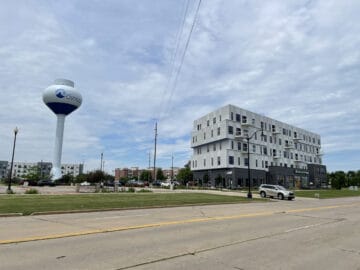 Is Oshkosh on pace to reach its housing goals?
Is Oshkosh on pace to reach its housing goals?


